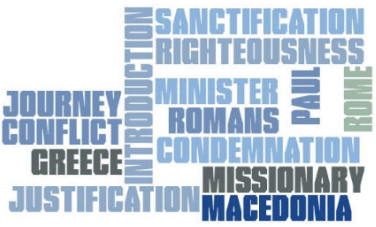This letter was written by the apostle Paul and sets forth the doctrine of justification by faith and its ramifications. Paul presents his case logically. It is a brilliant work that is very deep and yet easy to read. The main theme of the epistle is the righteousness of God, 1:16-17. The book of Romans is the most formal of all the letters written by Paul, and this serves and an introduction to Romans. Download this article in Microsoft Word.
“It is almost universally accepted that Romans was written near the close of the so-called third missionary journey, after an extended ministry of between two and three years at Ephesus (Acts 19:8, 10). At the conclusion of this ministry, during which time he had kept in close touch with the church at Corinth by writing and a hurried visit (see 2 Cor. 2:1), he journeyed to Macedonia (Acts 20:1) and spent three months in Greece (Acts 20:2f) before setting out for Jerusalem to deliver the collection he had gathered for the poor there. This three-month stay in Greece was likely at Corinth (see 1 Cor. 16:5f.).” (Bromiley, Geoffrey W., ed. The International Standard Bible Encyclopedia, Revised. Wm. B. Eerdmans, 1979–1988.)
- Written by whom – Paul is the author, per Romans 1:1, 5, 7.
- Written to whom – The book of Romans was written to the Christians in Rome. They were predominately Gentile, 1:13; 11:13.
- Why was it written – Paul was anxious to minister in the church there, so he wrote a letter preparing the way. He wrote it from the city of Corinth.
- Date written – From 55 – 58 A.D.
Romans Outline
- Introductory Matters (1:1-17)
- God’s Righteousness Revealed in Condemnation (1:18-3:20)
- Condemnation against pagan humanity (1:18-32)
- Condemnation according to divine standards (2:1-16)
- Condemnation against unfaithful Jews (2:17-3:8)
- Condemnation against all human beings (3:9-20)
- God’s Righteousness Revealed in Justification (3:21-5:21)
- Provided righteousness explained (3:21-31)
- Provided righteousness illustrated (chap. 4)
- Provided righteousness enjoyed (5:1-11)
- Provided righteousness contrasted (5:12-21)
- God’s Righteousness Revealed in Sanctification (chaps. 6-8)
- The ground of sanctification (6:1-4)
- Attitudes for sanctification (6:5-23)
- Conflict in sanctification (chap. 7)
- Power for sanctification (8:1-17)
- The goal of sanctification (8:18-27)
- Certainty of sanctification (8:28-39)
- God’s Righteousness Revealed in Sovereign Choice (chaps. 9-11)
- God’s sovereign choice is enunciated (9:1-29)
- God’s sovereign choice applied (9:30-10:21)
- God’s sovereign choice fulfilled (chap. 11)
- God’s Righteousness Revealed in Transformed Living (12:1-15:13)
- The basic consecration (12:1-2)
- In Christian ministry (12:3-8)
- In social relationships (12:9-21)
- In relation to authority (13:1-7)
- In light of the future (13:8-14)
- In dealing with other Christians (14:1-15:13)
- Concluding Remarks (15:14-16:27)
- Personal plans (15:14-33)
- Personal greetings (16:1-16).
- Final words (16:17-27)




